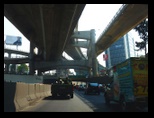
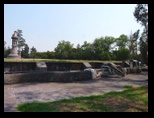
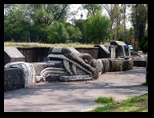
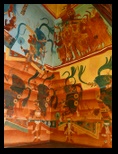
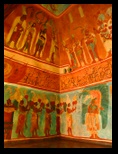


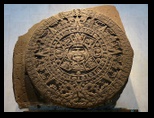
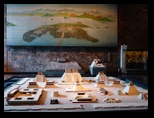

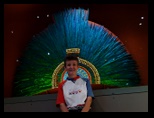
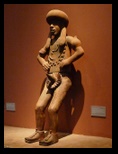
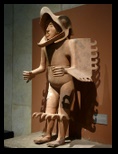
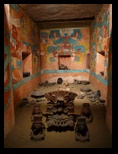
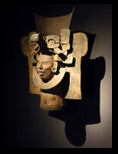
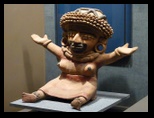

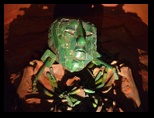
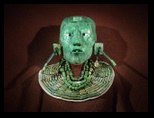
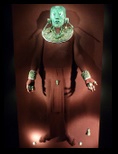

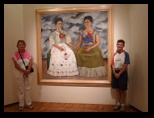
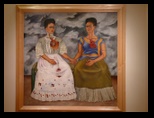
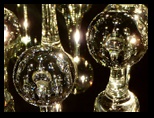
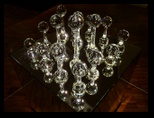
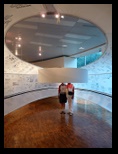


Click on a photo to enlarge it.
Annette needed to go to the dentist today and dropped us off at Chapultepec Park. We went to see the ancient aqueduct. Not really worth seeing.
Later on we met up with Annette in the National Anthropology Museum. Here are assembled the major archaeological and ethnographic collections gathered in Mexico since the 18th Century.
In the early sixties, the construction of a building of such dimensions required close cooperation between architects, museologists, anthropological researchers,
artists, designers, and engineers to build, in record time, the imposing edifice that today stands before us, virtually unchanged since its formal inauguration in
1964.
The size of the project and the unique nature of this museum enable its 26 exhibit halls containing one of a kind exhibits, maps, explanatory illustrations and
audiovisual presentations, to be visited both chronologically and by cultural region.
We have seen a lot of the artifacts already at their original places in the Yucatan and Oaxaca. It is still very impressive to experience all the Mexican cultures right next to each other.
The most famous exhibit here is the Aztec sunstone.
Following the first interpretations of the intricately carved hieroglyphs it was labelled the Aztec Calendar Stone. In current thought Stone of the Fifth Sun is
considered a more apt moniker. Though scholars have long debated the stone's meaning and purpose, they still puzzle over its many mysteries. Some suggest that,
fixed horizontally, it served as a sacrificial altar. Most now agree that it offers a graphic representation of the Mexican cosmos.
The calendar is evidence of the Aztec's knowledge of astronomy and mathematics. The calendar contained the pictographs for
their days, months and suns (cosmic cycles). The stone is three feet thick, 3.6 meters (12 feet) in diameter and weighs about 24 metric tons. It
took 52 years to complete, from 1427-1479, it is believed due to the use of only stone tools. This calendar is 103 years older
than the Gregorian calendar which is used worldwide today.
Originally the Calendar Stone was placed atop the main temple in Tenochtitlan, the capital
of the Aztec empire. Today, Mexico City's cathedral stands on the site. The Aztec calendar faced south in a vertical position
and was painted a vibrant red, blue, yellow and white. The stone was buried by the Spaniards when they conquered
Tenochtitlan. It was lost for over 250 years until December of 1790 when it was found by accident during repair work
on the cathedral. A veritable monument to art and science, the monolith initially remained at the Zócalo, embedded for viewing in the base of the west tower
of the Metropolitan Cathedral. A hundred years later it was transferred to Mexico's National Museum of Anthropology, where today it stands as the institution's
centrepiece.

The face of Tonatiuh is in the center circle of the stone. Around the face are four squares, or Four
Movement. According to Aztec legend, these squares represented the different ways that the four previous suns (or worlds)
had come to an end: first by wild animals, then by wind, by fire, and by floods. The Aztecs believed they were living in the fifth
and last world.
Continuing outward, the next concentric circle shows twenty squares, each naming one of the twenty different days of the Aztec
month.
The Aztec year consisted of eighteen months, each having 20 days. Each month was given a specific name. This arrangement
took care of 360 days (18x20), to which five dots were added inside the circle. These dots, known as Nemontemi, were
sacrificial days.
The next concentric circle is composed of square sections with five dots in each section, probably representing weeks of five
days. Next are eight angles dividing the stone in eight parts. These represent the suns rays placed according to the cardinal
points.
On the lower portion of the stone, two enormous snakes encircle the stone and face each other. Their bodies are divided into
sections containing the symbols for flames, elephant-like trunks, and jaguar-like forelegs. It is believed that these sections are
also records of fifty-two year cycles. A square is carved at the top of the calendar between the tails of the snakes. Inside the
square the date 13 Acatl is carved. This corresponds to 1479, the year the calendar was finished.
Eight equally spaced holes appear on the very edge of the calendar. The Aztec placed horizontal sticks here and the shadows
of the sticks would fall on the figures of the calendar; thus the stone also served as a sundial.
Montezuma's headdress is another attraction here although the original currently rests in the Museum of Ethnology in Vienna -
a source of dispute between Austria and Mexico, as no similar pieces remain in Mexico. Although attributed to Montezuma and the Spanish
conquest, the provenance of the piece is unattested, and it does not match Aztec illustrations of the headdress of their nobility.
It is made of quetzal and other feathers mounted in a base of gold studded with precious stones. It is 116 cm high and 175 cm across
and has the form of concentric layers of different coloured feathers arranged in a semicircle.
We also loved the replicas of the various tombs with fantastic jade masks and jewellery. You need days to see all of the museums exhibits.
We didn´t even go upstairs! Next time! We needed a little rest and had lunch in the café. No doubt Helen enjoyed her brownie more than
the rest of the museum!
Afterwards we walked to the Museum of Modern Art. The main attraction here is the famous painting of Frida Kahlo - Las Dos Fridas (The two Fridas).
It was painted after her separation from Diego Rivera and shows the depth of her pain. The Frida on the left represents the unloved, unwanted Frida in
a European style dress. The Frida on the right represents the real Frida in the traditional Tehuana dress. She is holding an amulet containing a childhood
picture of Diego Rivera. A bloodstream runs from the amulet to her heart and then over to the second Frida´s heart. An open, possibly broken heart and a bloodstream
leaking blood on her white dress, which Frida is trying to stop. Storm clouds in the background represent her mood.
An amazing painting!
There were other interesting exhibits in the museum. Kirsten loved the reflections of a glass art. Helen and Annette lost their heads in an ellipse made of fabric, which
contained the studies about pollution in and around Mexico City.
And we watched the video of two Panamericana travellers for more than half an hour. In 2008 Agnes Maret and Juan Miguel Gutierrez drove 30.000km in 13 months in their vehicle
by only using bio diesel. They found used vegetable oil all even in the most remote areas of South America, cleaned them with a huge pump and stored them in approx. 40 gas cans in and on top
of their truck. No space for sleeping or living though, so they had to move into hostels many times or sleep in a tent outside.
Two museums in a day was enough for us. We were really tired but Annette wanted to show us some more sights in Mexico City and took us on a trip around the city centre. All the roads
were blocked around the Zócalo due to an event and we got stuck in the heavy traffic.
Too tired to cook, we went out for a pizza that night.